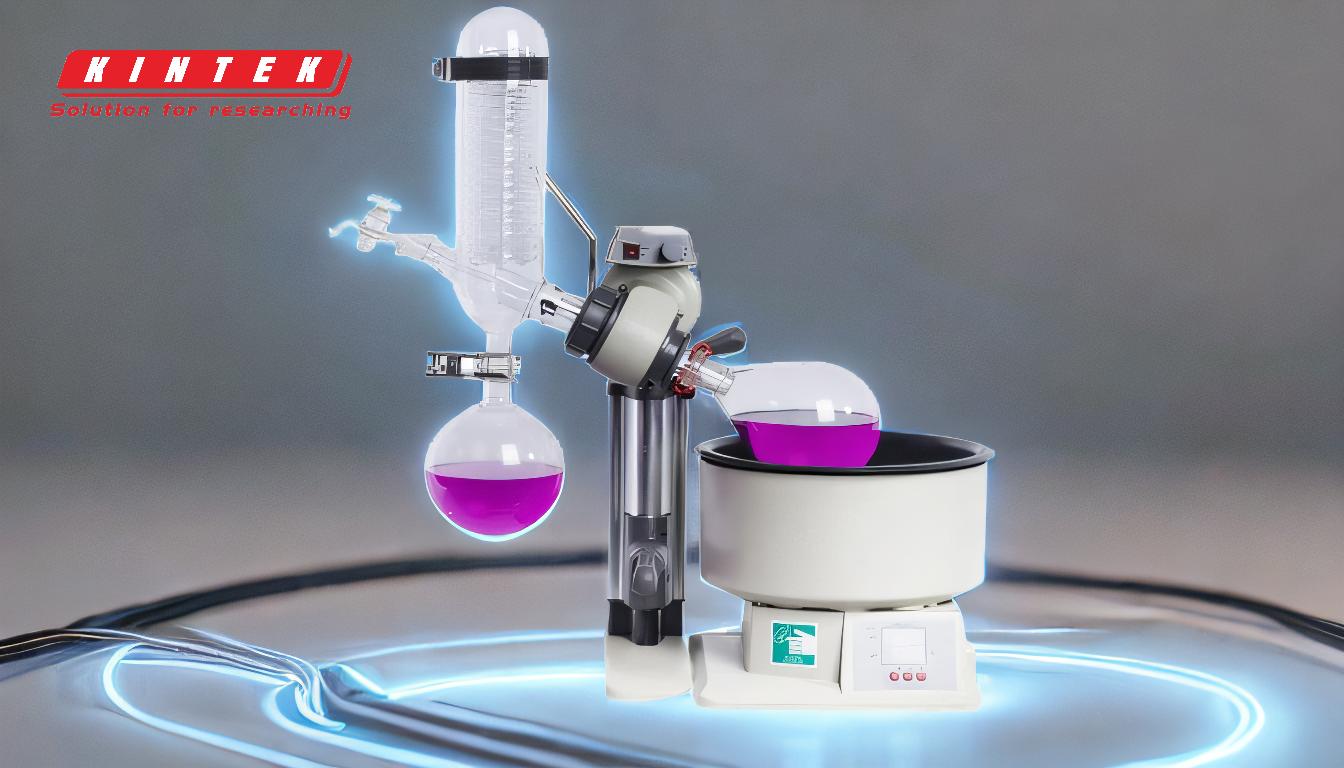A rotary evaporator is a laboratory instrument designed to efficiently and gently remove solvents from samples through evaporation under reduced pressure. It works by rotating a flask containing the sample, which increases the surface area for evaporation and allows for faster and more controlled solvent removal. The process involves heating the sample, creating a vacuum to lower the boiling point of the solvent, and condensing the evaporated solvent into a separate collection flask. This method is widely used in applications such as distillation, drying, concentration, and chemical synthesis, making it a versatile tool in laboratories.
Key Points Explained:

-
Principle of Operation:
- The rotary evaporator operates under reduced pressure, which lowers the boiling point of the solvent, allowing it to evaporate at lower temperatures.
- The evaporation flask is continuously rotated, creating a thin film of the sample on the inner wall of the flask. This increases the surface area for evaporation, speeding up the process.
-
Components and Their Functions:
- Evaporation Flask: Holds the sample and rotates to create a thin film for efficient evaporation.
- Heating Bath: Provides controlled heating to the flask, ensuring even evaporation.
- Vacuum Pump: Reduces the pressure inside the system, lowering the boiling point of the solvent.
- Condenser: Cools the evaporated solvent, converting it back into a liquid.
- Receiving Flask: Collects the condensed solvent, separating it from the non-volatile components of the sample.
-
Process Steps:
- Rotation: The flask is rotated at a constant speed, ensuring the sample forms a thin film on the flask wall.
- Heating: The flask is heated evenly, causing the solvent to evaporate at a lower temperature due to the reduced pressure.
- Evaporation: The solvent evaporates and moves into the condenser.
- Condensation: The solvent vapor is cooled in the condenser and collected in the receiving flask.
- Collection: The condensed solvent is stored in the receiving flask, while the non-volatile components remain in the evaporation flask.
-
Applications:
- Distillation: Efficiently separates solvents from mixtures.
- Drying: Removes solvents from samples, leaving behind dry residues.
- Concentration: Reduces the volume of a sample by removing excess solvent.
- Chemical Synthesis: Facilitates reactions under reflux conditions.
- Extraction: Isolates natural compounds from complex mixtures.
- Freeze-Drying Preparation: Prepares samples for lyophilization by removing solvents.
-
Advantages:
- Speed: The process is faster than traditional evaporation methods due to the increased surface area and reduced pressure.
- Gentle: Lower temperatures prevent degradation of heat-sensitive compounds.
- Versatility: Suitable for a wide range of solvents and applications.
- Efficiency: High recovery rates of solvents and minimal loss of sample.
-
Considerations for Purchasers:
- Capacity: Choose a model with an appropriate flask size for your sample volume.
- Vacuum Performance: Ensure the vacuum pump can achieve the necessary pressure reduction for your solvents.
- Temperature Control: Look for precise temperature control to handle heat-sensitive materials.
- Material Compatibility: Ensure the system is compatible with the solvents and chemicals you plan to use.
- Ease of Use: Consider models with user-friendly interfaces and easy-to-clean components.
- Safety Features: Look for features like automatic shut-off and pressure release valves to ensure safe operation.
In summary, a rotary evaporator is an essential tool in many laboratories, offering a fast, efficient, and gentle method for solvent removal. Its ability to operate under reduced pressure and at lower temperatures makes it ideal for a wide range of applications, from distillation to chemical synthesis. When purchasing a rotary evaporator, it's important to consider factors such as capacity, vacuum performance, and safety features to ensure it meets your specific needs.
Summary Table:
| Aspect | Details |
|---|---|
| Principle of Operation | Operates under reduced pressure, lowering solvent boiling points for gentle evaporation. |
| Key Components | Evaporation flask, heating bath, vacuum pump, condenser, receiving flask. |
| Process Steps | Rotation, heating, evaporation, condensation, collection. |
| Applications | Distillation, drying, concentration, chemical synthesis, extraction. |
| Advantages | Fast, gentle, versatile, efficient. |
| Purchasing Tips | Consider capacity, vacuum performance, temperature control, safety features. |
Discover how a rotary evaporator can enhance your lab’s efficiency—contact us today for expert advice!










